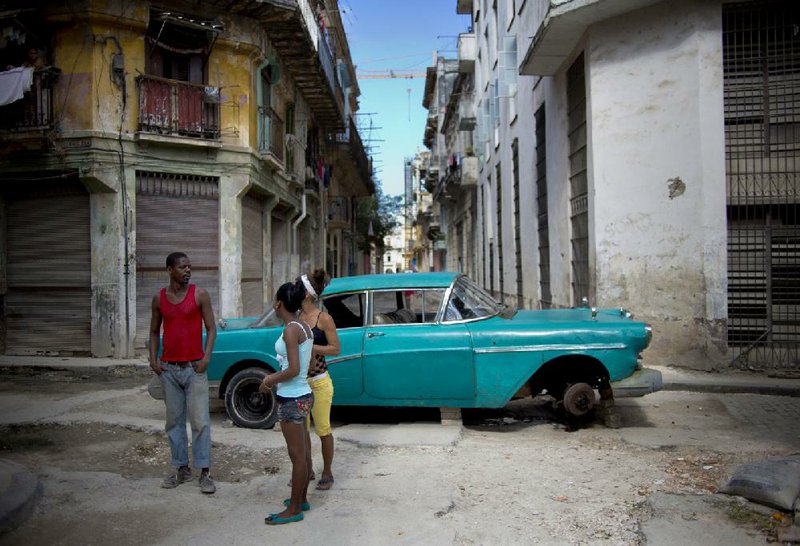HAVANA - The dented metal pizza trays are packed away, so too the old blender that never worked when it was needed. Gone is the sweet smell of rising dough that infused Julio Cesar Hidalgo’s Havana apartment when he and his girlfriend were in business for themselves, churning out pizzas for hungry costumers.
Two years on the front lines of Cuba’s experiment with limited free market capitalism has left Hidalgo broke, out of work and facing a possible crushing fine. But the 33-year-old known for his wide smile and sunny disposition said the biggest loss is harder to define.
“I feel frustrated and let down,” said Hidalgo, slumped in a rocking chair one recent December afternoon, shrugging his shoulders as he described the pizzeria’s collapse. “The business didn’t turn out as I had hoped.”
The Associated Press recently checked in with small business owners whose fortunes it first reported on in 2011 as they set up shop amid the excitement of President Raul Castro’s surprising embrace of some free enterprise.
Among them were restaurant and cafeteria owners, a seamstress and tae kwon do instructor, a vendor of bootleg DVDs and a woman renting her rooms out to well-heeled tourists.
Of the six ventures that relied on revenue from cash-strapped islanders, four are now out of business, their owners in more dire financial straits than when they started. But the three enterprises that cater to well-heeled foreigners, and to the minority of well-paid Cubans who work for foreign businesses, are still going and in some cases thriving.
While the sample size is small, the numbers point to a basic problem that economists who follow Cuba have noted from the start: There simply isn’t enough money to support a thriving private sector on an island where salaries average $20 a month.
“Clearly, there is a macroeconomic environment that does not favor the private sector or the expansion of demand that the private sector requires,” said Pavel Vidal, a former Cuban Central Bank economist.
Vidal has long called on Communist authorities to adopt a huge stimulus package or more aggressively seek capital from foreign investors. Now a professor at Colombia’s Javeriana University, he said one has only to look at the trends since 2011 to see the private-sector economy is nearly tapped out. After a surge of enthusiasm, the number of islanders working for themselves has stalled for the past two years around 444,000 - or 9 percent of the workforce.
Even in developed countries where entrepreneurs have access to capital, loans and a wide pool of paying customers, startups are risky ventures. According to the U.S. Small Business Administration, about half of all new establishments in America close within five years, and two-thirds are gone within a decade. The failure rate of Cuban entrepreneurs followed by AP was 44 percent in less than two years, and worse if one considers only those that relied primarily on Cuban customers.
“There’s not enough money circulating in the economy in the hands of everyday people,” said Ted Henken, a professor of Latin American studies at Baruch College in New York and author of a forthcoming book on private enterprise in Cuba. “You’re all competing for the same customers, most of whom are poor and have very limited disposable income.”
Economists have criticized the Cuban government for a series of measures to crack down on what it sees as illegal activities - including banning private movie cinemas, taxing the import of hard-to-get products in travelers’ luggage and banning the sale of imported clothing. But on Dec. 21, Castro came down firmly in favor of increased regulation, sternly warning entrepreneurs that “those pressuring us to move faster are moving us toward failure.”
Henken and Vidal said Cuba must find a way to raise state salaries, expand state-funded microcredits and create a functional wholesale market to service the new businesses. They also said that for a relatively well-educated society such as Cuba’s, there are remarkably few white-collar jobs on the list of nearly 200 activities that have been legalized.
Still, not every entrepreneur is struggling.
High-end bars and glamorous new restaurants have become common in Havana, with new state tour buses disgorging photo-snapping travelers to sample lobster tail and filet mignon at upward of $20 a plate. Private rooms and homes that rent to foreigners can go for $25-$100 a night, less than most tourist hotels. Cubans with the means, and the business sense, to tap into the gravy train can do well.
Chef-owner Javier Acosta sank more than $30,000 into Parthenon, a private restaurant catering to tourists and diplomats. He struggled at first, telling the AP back in 2011 that there were nights when nobody came in and he and his four waiters just sat around.
But the restaurant slowly gained a reputation, in part because Acosta makes a potent Cuban mojito and offers a special suckling pig that can feed up to five people for $50.
These days, Acosta is expanding. He recently added tables in a new room decked out with mosaic tiles and faux Greek pillars, and he plans to build a roof deck. He even has started advertising, paying $300 a year to have his establishment included in a tourist magazine.
“I haven’t yet managed to recover my initial investment and the other money we’ve put into the place,” the 40-year-old said. “But in two or three more years, maybe I can.” Information for this article was contributed by Michael Weissenstein and Paul Haven of The Associated Press.
Business, Pages 31 on 12/28/2013

